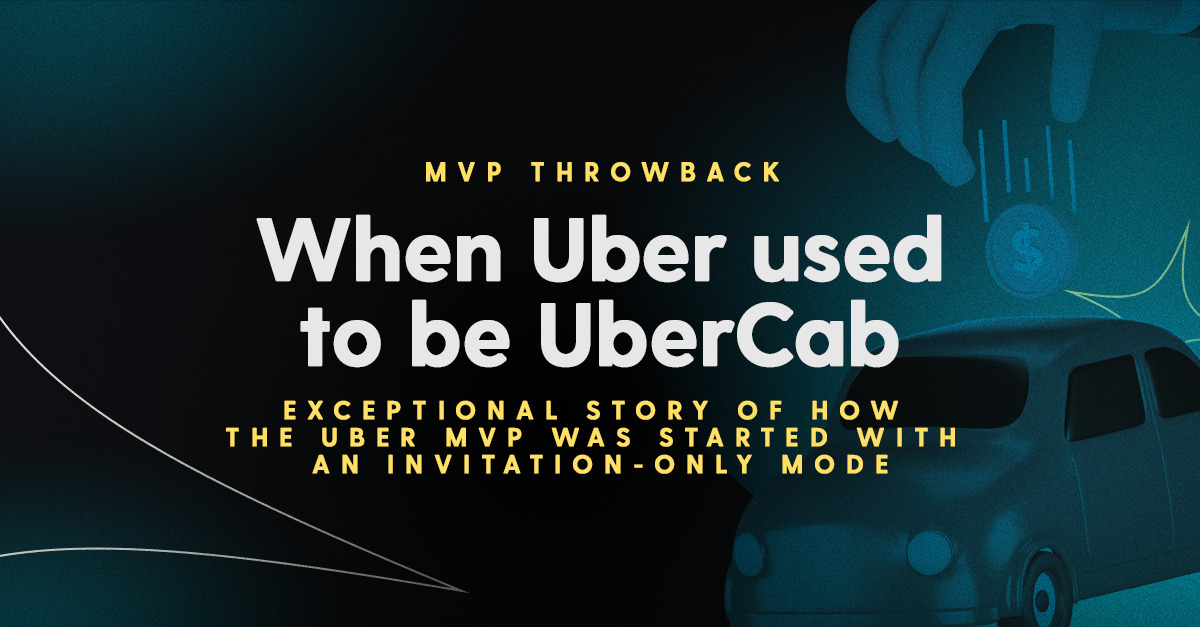Uber is a technology giant, valued in 2023 at more than $63 billion dollars, operating in 70+ countries.
However, although the company grew very fast, it wasn’t always a large company.
In fact, Uber’s MVP was run with only a very limited amount of features targeted at an invitation only audience.
In this article, we walk through the steps that Uber took to create their MVP this includes:
- How Uber found their marketplace idea
- How Uber validated their idea
- What features were included in the Uber MVP (including screenshots and product demos of their MVP apps)
- How Uber onboarded their first users
- How Uber raised capital
- And details of Uber’s business model
First up though, let’s take a brief look at what exactly Uber is.
What is Uber?
In technical terms, Uber is a Transportation Network Company (TNC) that operates a peer to peer marketplace which connects riders with drivers through a mobile application.
The platform uses technology to match people looking for transportation with nearby drivers. The solution also provides real-time tracking of vehicles and passengers so that drivers and riders can find each other, handles payments and offers features such as driver and passenger ratings.
Uber aims to provide a lower cost and superior way of booking a ride compared to the traditional model of flagging down a taxi in the street or calling a taxi company to book a cab.
As of 2023, Uber has more than 150 million active users and has facilitated more than 47 billion trips since inception in 2010.
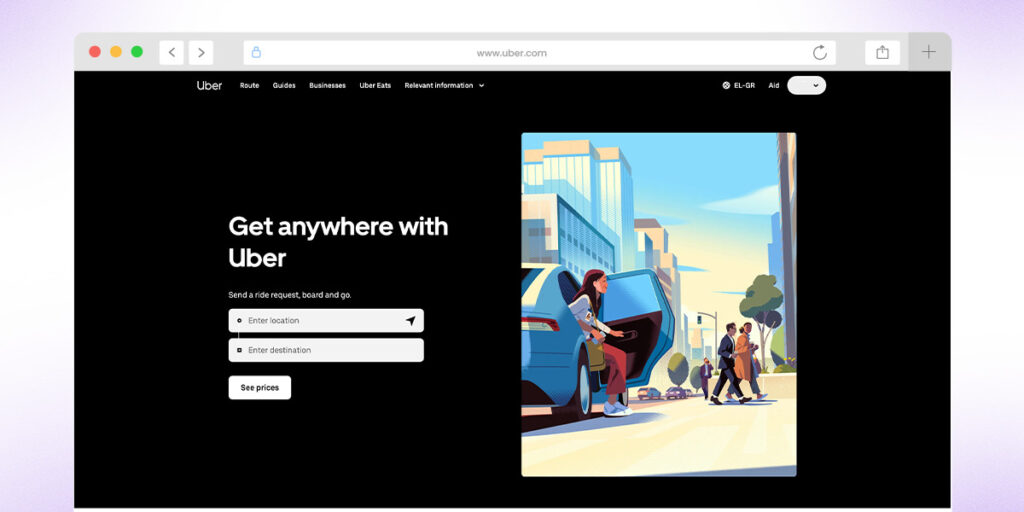
How to build an Uber MVP: The story of UberCab
There are three main ways to build an app like Uber: custom code, specialist marketplace technologies and traditional no-code platforms. Each of these options has their pros and cons which we cover in our article how to choose your marketplace tech stack.
One method you can use is our hybrid no-code platform Dittofi. This can be used to build an app like Uber. However, there is a lot more to building a successful marketplace than just getting the code for the platform developed. Below are the steps that Uber’s founders took to build the Uber MVP.
- Finding a problem to solve
- How Uber validated their idea
- Scoping the Uber MVP
- Onboarding supply and demand
- Raising capital and scaling
Let’s take a look at exactly how Uber went through these different stages of marketplace development now.
How Uber found a problem to solve
“A common theme in my ventures is that I am always looking for one simple user action that will do something very useful or very valuable. So with Uber you click and a car comes”
– Garrett Camp, Co-Founder Uber.
Uber was founded by serial entrepreneur Garrett Camp in 2008.
Garrett documents that the idea for Uber came to him as a result of his frustrations of trying to hail a cab in San Francisco.
Garret tried out other ride-hailing companies such as Taxi Magic and Cabulous, neither of which worked very well. He therefore realized that he had found a problem that no existing system solved. In a nutshell, the problem was that there was no convenient way to hail a taxi in San Francisco. Garrett saw this problem as an opportunity to build his own transportation company that solved the problem better than the existing systems. However, it wasn’t until Kalanick joined in 2009 that the company business model started taking shape.
In 2009 Travis Kalanick and Garrett were on a night out in Paris. When taking a taxi, the Parisian taxi driver felt that the pair were being too boisterous. The driver threatened to kick the young entrepreneurs out of the taxi if they didn’t calm down. Travis was so insulted that he decided to voluntarily leave the taxi. Getting out of the cab on the side of the road the pair were stranded in the middle of a snow storm and were unable to hail a taxi. At this point Travis recognized the problem of hailing a taxi was huge and decided to join in the mission to build Uber.
Whilst the two founders had identified a problem to solve, they could not agree on a method to solve the problem. Garrett wanted to buy a fleet of mercedes and make these available on demand. Travis meanwhile had extensive experience building peer to peer networks from his previous startup and convinced Garrett that the best way to solve the problem of hailing a taxi was with a peer to peer (p2p) marketplace. In this model Uber would not own any inventory and would instead simply be an app that would match people looking for a taxi with drivers (not necessarily taxi drivers) in the area.
“Uber was made possible by the state of technology at that time. Where most people owned smartphones, had access to app stores, mobile phones had good battery life and GPS. This made it the right solution at the right time.”
– Garrett Camp, Co-Founder Uber.
Once the problem had been defined and a broad idea for a solution the two serial entrepreneurs began designing their initial product.
How Uber validated their idea
One of the classic entrepreneurial mistakes is thinking that your product is for everyone.
No product in the world is for everyone and Uber is no exception. Although Uber operates in 70 countries around the world, it does not operate in every country or every city in the world. Therefore Uber is not for everyone.
In its early days Uber was even more niche.
At the start, the Uber founders decided that they would focus on a niche market. The founding team decided to target the San Francisco market. Within this market they then targeted limo drivers (on the supply side) and passengers who wanted a high end taxi service (on the demand side). The goal of Uber was to connect these two groups of people together with a marketplace technology.
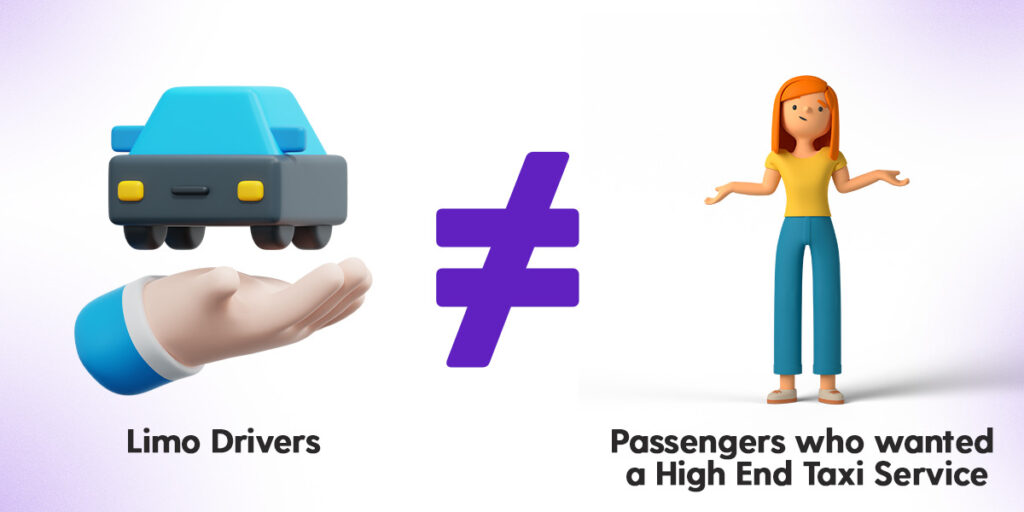
All two sided marketplaces need to validate that there is market demand for the marketplace on both the supply and demand side. There are several text book ways to validate marketplace ideas.
In the case of Uber, Travis validated the supply side by calling up several limo drivers. He then pitched the concept to these drivers and asked if they would be interested in listing their services on the marketplace. When 3 out of 10 drivers that he spoke to said “yes”, Travis considered that the idea was validated.
Meanwhile, on the demand side, Travis and Garrett priced limos listed on their platform lower than the nearest competitive alternative. In effect this eliminated the need to test the market demand since people already booked limos through their phones, Uber was just offering a better, lower cost alternative.
You can compare UberCab’s target demographic on the passenger side to the type of person who would rent out a Lincoln town car which is more expensive than a taxi but also comes with more comfort, professionalism, reliability and so on. The pricing breakdown to book a limo through Uber compared with a regular taxi service in the first years of operation is shown below. Notice how the pricing is dependent on the city. This is because demand for a taxi varies per city based on market demand.
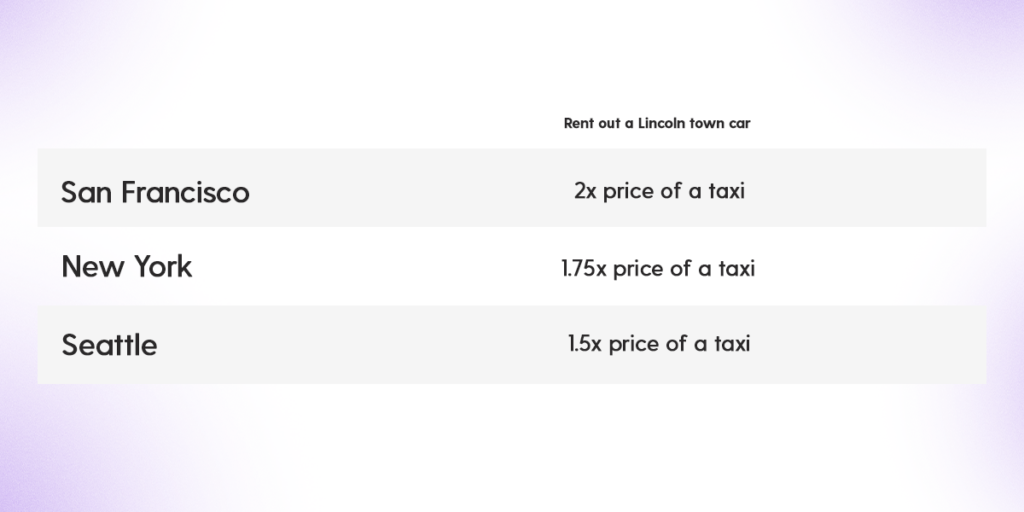
So – UberCab was 90% cheaper than a Lincoln Town car but provided users a significantly more convenient and comfortable experience than a Lincoln Town car.
Uber itself planned to make money off their product by taking a percentage commission of every transaction that took place on Uber.
This was Uber’s business model in the early days and it was focused purely on a target demographic of limo drivers and passangers that would actually be willing to pay a premium for convenience. It wasn’t until later on that Uber started to offer price competitive alternatives to taxis.
Scoping the Uber MVP
Once the founding team had come up with an idea and done the initial product validation, the next step was to build their marketplace MVP or minimum viable product.
Uber’s MVP was called UberCab.
The product was initially targeted at friends of the founders who were given exclusive rights to use Uber’s MVP. A video demo of UberCab is included at the end of this section.
Uber’s MVP consisted of three apps, the UberClient for the consumer side of the marketplace, UberDriver for the limo drivers and UberCab web app for the drivers and passengers to onboard onto the platform. Let’s look at what features were included in each of these apps now, starting with the UberDriver web app.
What was included in Uber's MVP
Uber’s MVP consisted of three apps:
- UberClient (iOS mobile app) for the passanger side of the marketplace
- UberDriver (iOS mobile app) for the limo drivers
- UberCab web app for the drivers and passengers to onboard onto the platform and register their card details.
Let’s look at what features were included in each of these apps, starting with the UberDriver web app.
UberDriver Web App
The purpose of this app was to allow limo drivers to sign up and list their services on the uber app. Passengers could also sign up to the app, enter their payment information and then get access to the UberDriver app.
A short video of how the Uber MVP web app works is shown below.
The UberCab web app was targeted at limo drivers. The value proposition was that it would be an easy way for limo drivers to accept on demand bookings. The MVP contained the following set of features.
Sign up and login screens
Limo drivers are able to visit UberCab.com, sign up for the service with an email address and zip code of the service area and enter an invite code.
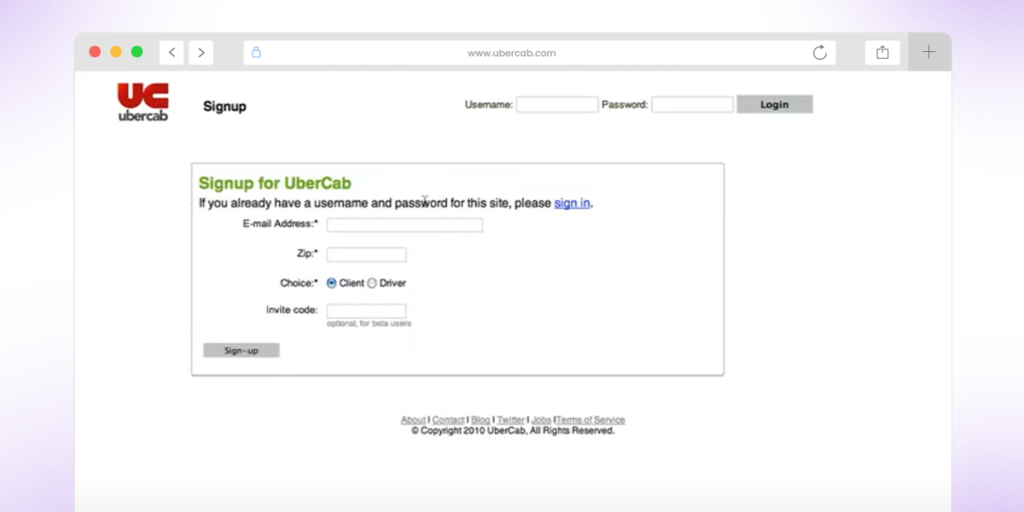
User profiles
Once the user signs up to UberCab.com, they are prompted to enter their account information such as first name, last name, username and so on. This information would create a user profile for the passenger and drivers.
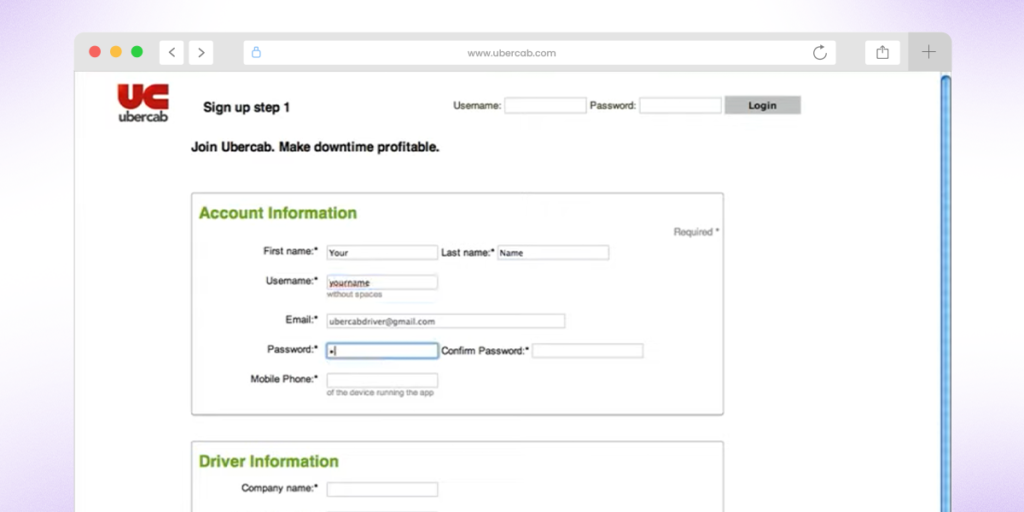
Set up payments via paypal
Payments were handled using Paypal in the early days, with payouts made to drivers on a weekly basis. At a later date, they would implement direct bank transfers to save on transaction fees.
Confirm email address
Once users had signed up to the web app, they would be sent an email that would allow them to confirm their email and activate their user registration.
Company dashboard
Finally, limo companies that registered with UberCab were given access to some other tooling. This included, being able to monitor their fleet of cars in real time, access trip logs, watch drivers earnings on a daily or monthly basis and lastly, track payments made.
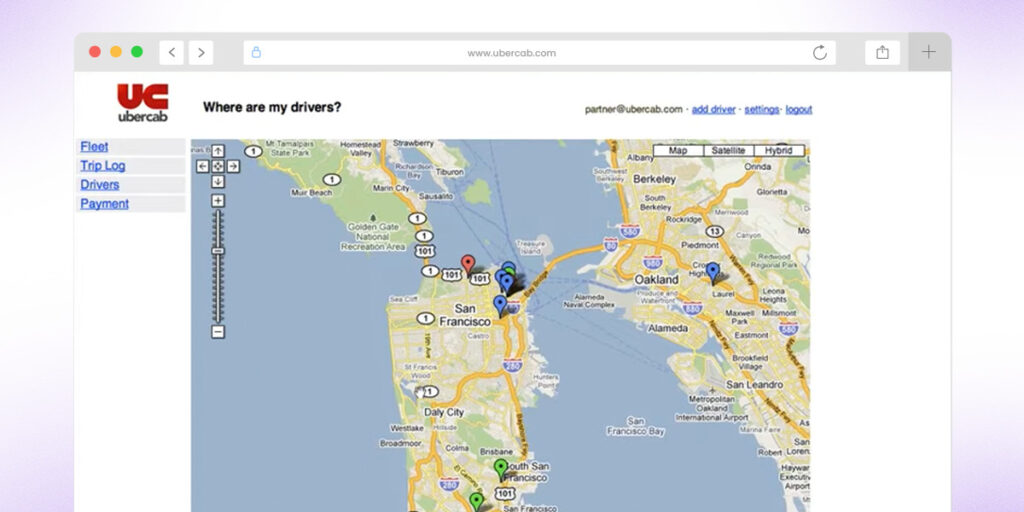
UberClient and UberDriver
The two apps UberClient and UberDriver have a suite of features that define the marketplace transaction flow. This is the flow that defines how the marketplace works.
A video demo of Uber’s MVP is shown below.
Let’s go through the features includes in UberClient and UberDriver.
Login and sign up screens
Both the UberClient and UberDriver app start on login and sign up screens. A screenshot of the login screen is shown below.
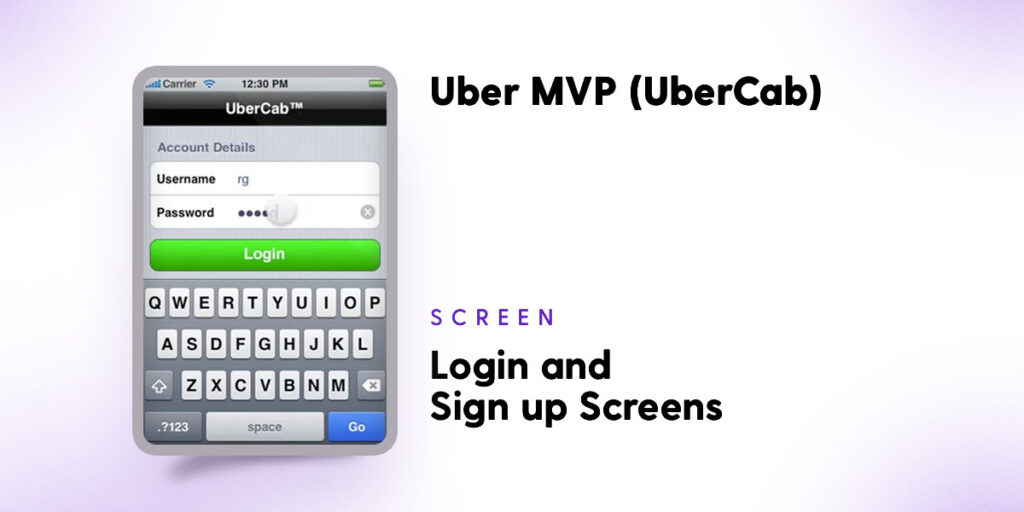
UberClient requests pickup
As soon as the client logs into UberCab, the application will detect the approximate location of the client and drop a pin on the map. The client can then click a button with the text “Pick me up” written on it. This zooms the map in, allowing the client to set their exact location and then click “Confirm pickup location”. This action kicks off UberCab’s marketplace transaction flow.
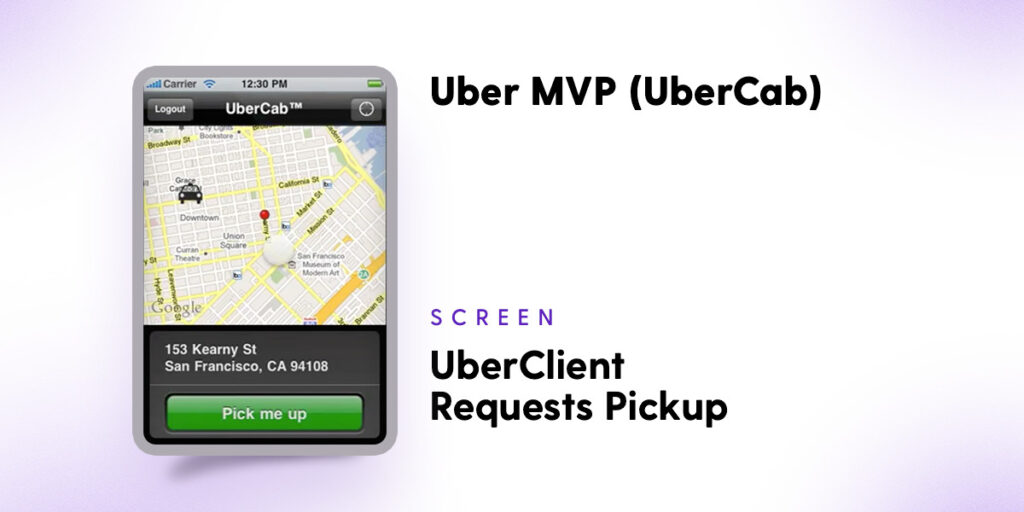
UberDriver to confirms pickup
As soon as a client requests a cab, a notification is submitted to a limbo driver using the driver app UberDriver. Embedded in the notification, the driver sees the location, the name of the client and the client rating. From there, the driver has 15 seconds to accept the request.
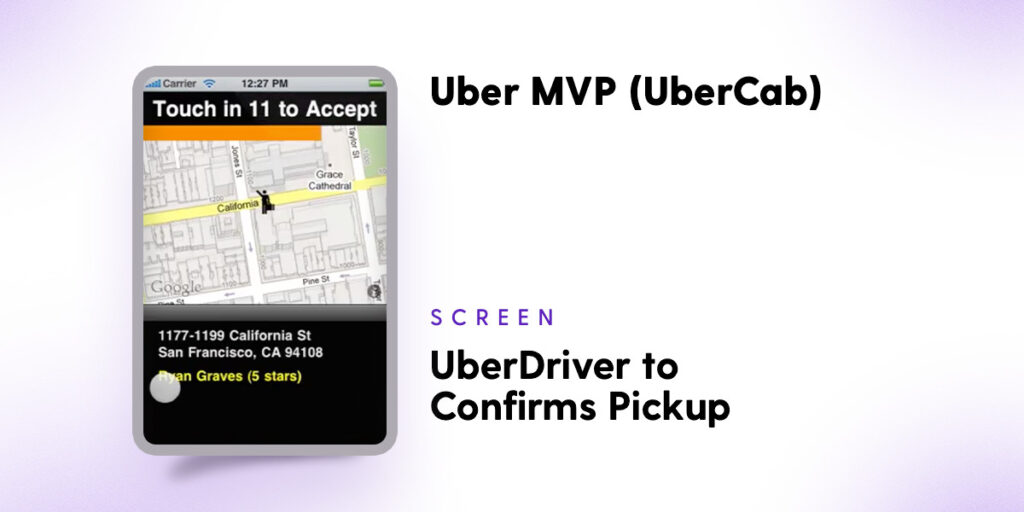
UberClient sets their destination
As soon as a driver accepts the request, the client is able to choose a destination to be dropped off at. Using the UberClient app, the client can either manually enter the address or choose from a list of saved destinations.
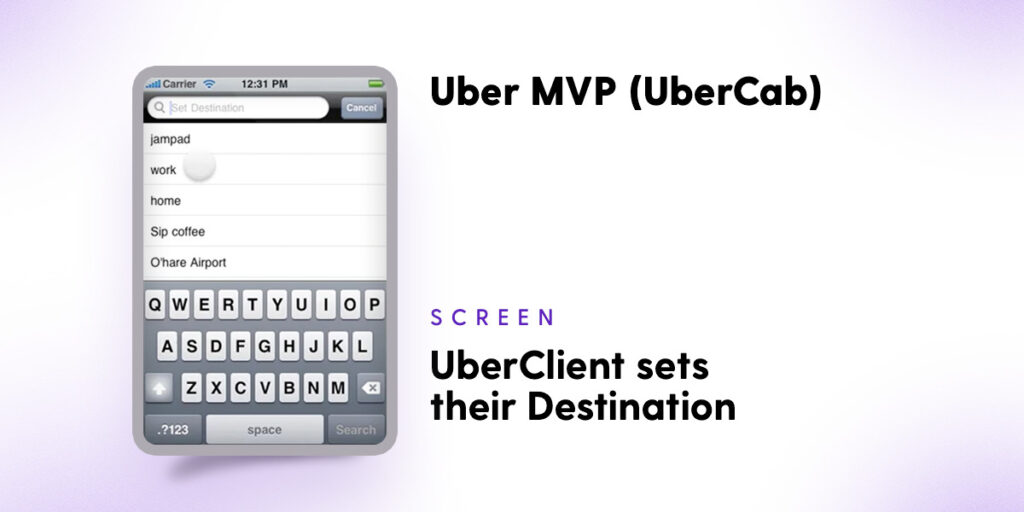
UberDriver and UberClient transact
Upon arrival at the client pick up point, the UberDriver clicks a button that says arriving now. Before starting the trip, the UberClient must confirm that the trip is starting now by clicking “Begin trip”. This allows the driver to begin the trip and start the fare.
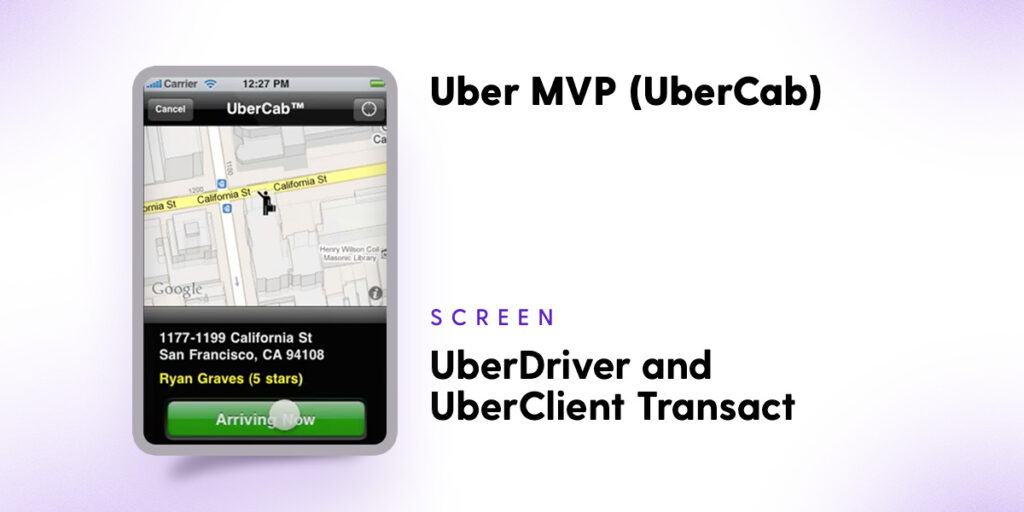
UberDriver gets the client destination
At this point, the UberDriver gets the client destination sent to them. The platform places a pin on the drivers app to let them see exactly where the client destination is set to.
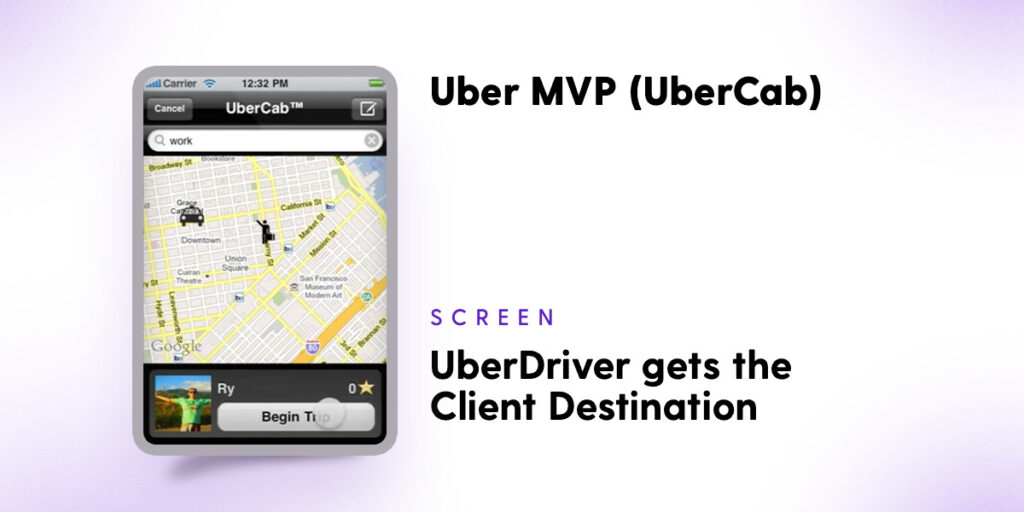
UberDriver ends the trip
Once the Uber driver arrives at the destination, the Uber driver clicks to end the trip. This gives the driver the option to rate the client from 1 to 5 stars and then submit that rating. Inside the UberClient app, the client is given the option to rate the driver from 1 to 5 and submit their rating.
Feedback option
UberClient asks for drivers and clients to leave feedback on their trip and in app user experience.
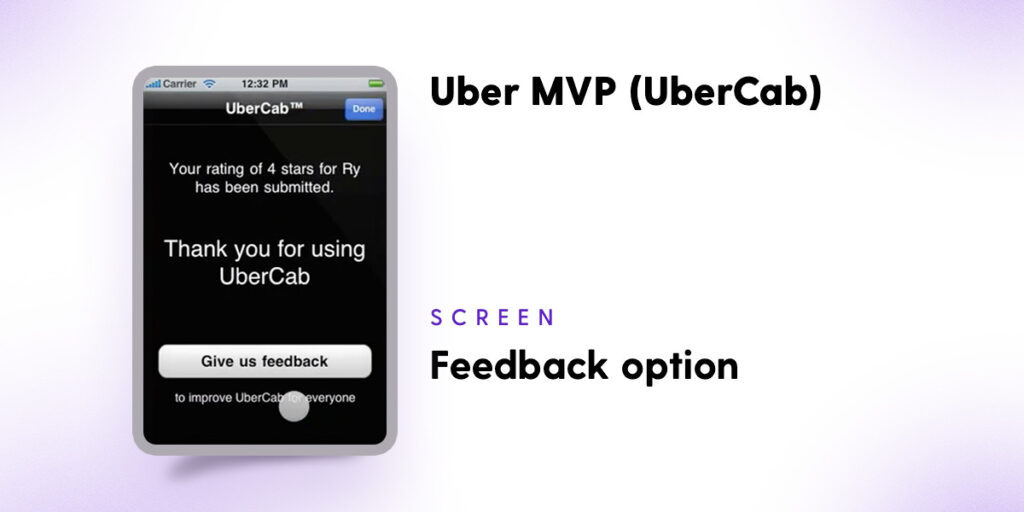
How Uber onboarded their first users
After Uber’s MVP had been developed, the next step was to start onboarding new users.
Getting your first users for a marketplace can be tricky. This is because you need both supply and demand to make the marketplace work. Without demand there is little incentive for supply to come to the marketplace and without supply there is little incentive for demand. This is known as the marketplace chicken and egg problem.
In Uber’s case, the company started by getting drivers (supply) to sign up to their marketplace. To do this, they approached limo car drivers and offered them access to their early user base. According to Kalanick only 3 out of every 10 limo car drivers accepted to sign up initially.
On the demand side, Uber was originally made available on an invitation only basis. You could not simply go to the app store and download the app, instead you needed to email Travis Kalanick directly, if approved, he would then provide you with unique application access codes to access the UberClient app.
Using this model, Uber got an increasing number of app downloads. This signalled that the founding team had validated their solution worked and they were ready to start getting more aggressive with their customer acquisition strategy.
How Uber expanded their user base
Uber expanded their user base rapidly.
The founding team did this by strategically launching the Uber product in locations and at times when demand for taxis exceeded driver availability. For instance, during New Year’s Eve in New York City, it is almost impossible to book a taxi. This meant that people looking to book taxis would be looking for alternative ways to book a ride. However, to be a viable alternative, Uber had to be able to service the demand for rides. So they introduced surge pricing which allowed drivers to charge more for their services than driving a traditional taxi. This secured a ready supply of drivers that were ready to meet the surge in demand.
This enabled Uber to rapidly onboard users, prompting them to download the app and discover a more convenient method of hailing rides.
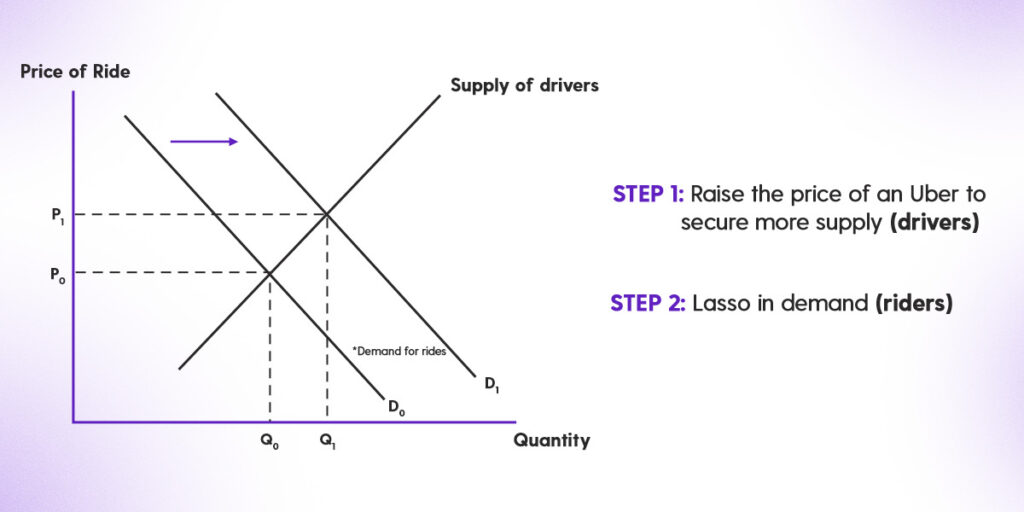
Raising capital and scaling Uber’s MVP
Both Travis Kalanck and Garrett Camp were serial entrepreneurs who had already had successful exits. This meant that raising capital for Uber was not a major challenge. Essentially the pair had a network of investors who had invested in previous ventures which had made those investors money. As such they were able to get seed money for Uber fairly easily.
Uber used this money to launch Uber’s MVP and scale to 8 different cities.
Following their early success, in 2011 Uber raised an $11.5 million Series A round from Bill Gurley at Benchmark. Travis explains that because of his previous success both as an serial entrepreneur and with Uber, he had a choice of venture capitalists to work with. He chose Bill Gurley and Benchmark because he thought that they were the best on the market.
Since 2011, Uber has continued to expand, raising multiple rounds of capital and completing an initial public offering (IPO) in 2019 for $120 billion. There is no one single factor that allowed Uber to expand so rapidly however, Travis Kalanick is credited with being a massive driver in the success of the organization.
Uber’s business model
Uber has an interesting business model that has evolved over 15+ years. As we have already seen, Uber is a peer to peer marketplace for different types of products. It connects the suppliers of different services with individuals and companies who need those services. To show you how Uber makes money using their marketplace model, let’s take a look at ride sharing as an example.
Uber's ride sharing business model
Uber’s ride sharing model connects people who need to move around the city with a network of drivers who are willing to provide this service. Each driver is an independent contractor and is not employed directly by Uber.
For all trips taken via the Uber app, Uber charge a commission. For instance, let’s assume that you take a ride on Uber and pay $30, which is the total value of the ride. A breakdown of what happens with that $30 is shown below.
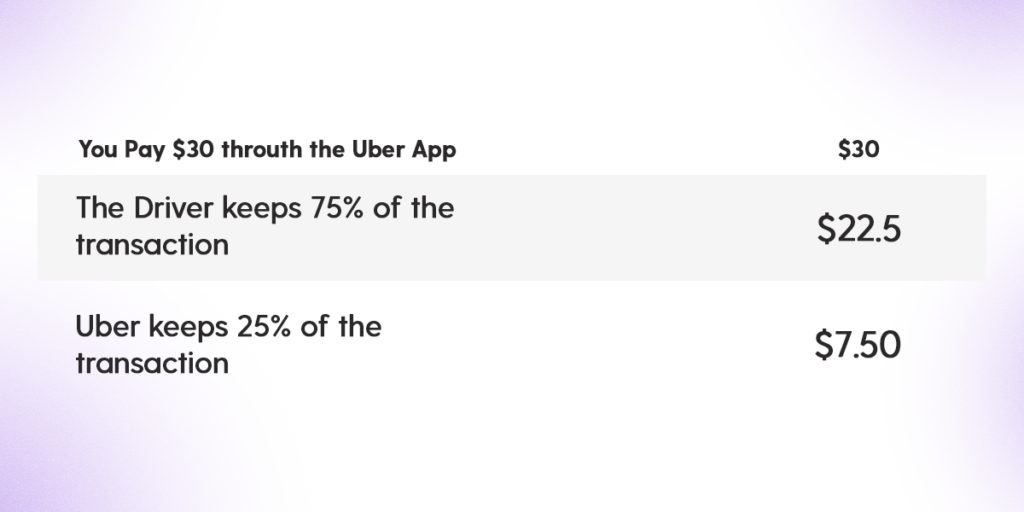
In reality Uber’s commission on each trip varies. Generally it falls between 20% and 25% however it can be as high as 50% on low cost trips.
For more information on different marketplace business models read What are the top marketplace business models.
Uber averages 28 million trips per day and they make a commission on each trip. This model therefore works very well for Uber and aligns well with their drivers who make more than they would have traditionally made as employees of a taxi company.
Uber also makes money by offering promotional partnerships. These are marketing campaigns run through the app and several times through the ride itself (for example, the BMW 7 Series offered free trips in their new car to promote it).
Uber’s success lies in their marketplace framework which includes advanced data analytics. This allows the company to dynamically price their rides so that they remain the a cost competitive solution for riders whilst simultaneously securing a ready supply of drivers.
“Uber isn’t a taxi company. It’s a data company” – Matt Denman, Uber Melbourne
Uber’s marketplace framework has been used by Uber to make money in other areas as well.
Uber’s business model is currently split up into four main business units: mobility (the original Uber), Uber Eats (focused on delivery), Uber Freight, Uber Connect and Uber Health. These are shown below.
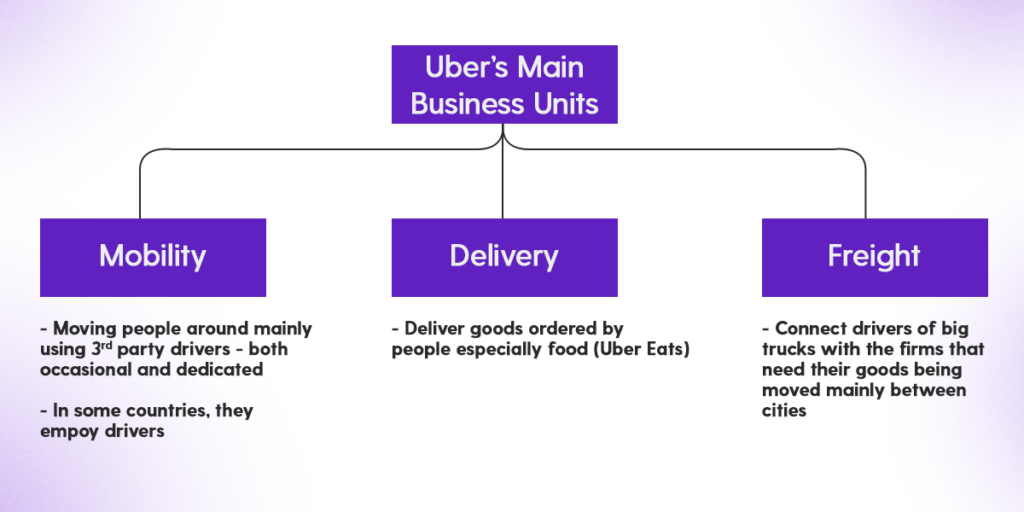
- Uber Mobility is the original Uber. This business line focuses on moving people around, mostly using third party drivers. Some of these third party drivers are driving part time for Uber, others are doing it full time. Notice that in some countries Uber does actually employee drivers or partners with existing companies to accelerate their supply of drivers.
- Uber Eats is a food delivery service that allows users to order meals from local restaurants and have them delivered to their doorstep by Uber drivers. The platform connects customers with a wide range of food suppliers.
- Uber Freight connects professional drivers of big trucks with the firms that need their goods to be moved, mainly between different cities.
- Uber Connect is a delivery service for sending packages or items to friends, family, or colleagues. Users can request a pickup and drop-off for packages, allowing for quick and reliable delivery without the need for traditional courier services.
- Uber health is a service designed for healthcare organizations to arrange transportation for patients to medical appointments.
Each of these different business units is in fact a marketplace. The only difference is the product that they are transporting. Over the last five years, the importance of each of these business units has changed.
The graph below shows the revenue for Uber Mobility, Uber Eats and Uber Freight from 2019 – 2021. As you can see, the
The changing importance of Uber's different business units
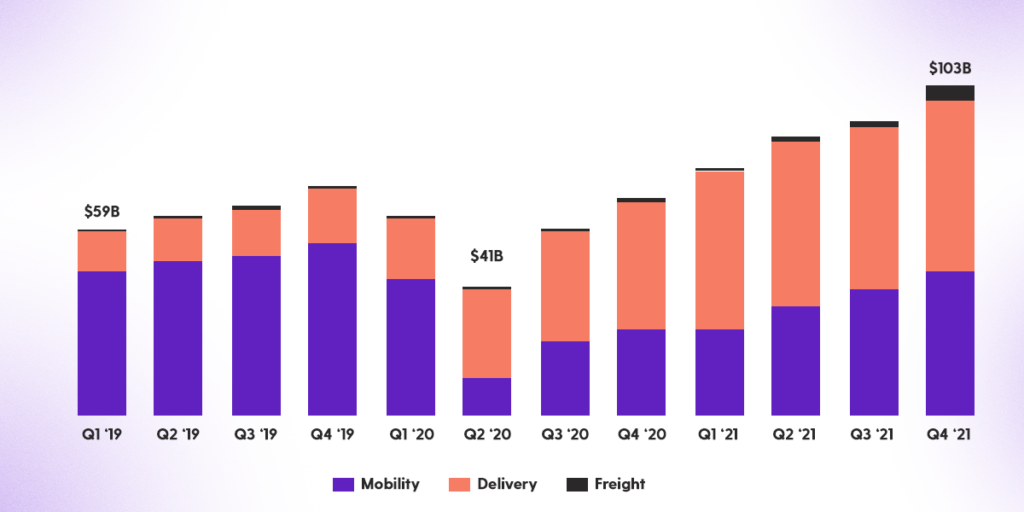
As you can see from the graph, Uber Mobility was the dominant business line until the COVID-19 pandemic. At the same time, the demand for Uber Eats increased significantly for that period. This was in part due to Uber’s acquisition of Postmates but mainly it was due to an increase in demand.
Uber’s competitors
Uber has several main competitors. These include companies such as:
- Lyft, which competes with Uber in the United States.
- DidiChuxing which operates primarily in China and South America.
- OlaCabs which targets the Indian market.
- Grab, which offers services in Singapore, the Philippines, Indonesia, Vietnam, Thailand, Myanmar, and Malaysia.
The main ways that these solutions look to differentiate themselves is by offering a higher supply of drivers to the market.
Conclusion: How to build a business like Uber
At its core Uber is a peer to peer marketplace technology that uses advanced analytics to connect supply and demand for various different products.
The technology was originally incubated as an on demand ride sharing model.
If you would like to build a business like Uber, there are many lessons you can take from this. One of the main ones is to start by developing a marketplace MVP which is focused on a target niche, just like Garrett and Travis did all the way back in 2009.
Nowadays building a marketplace MVP is far easier than it was 10 – 15 years ago. This is because there now exist a range of different marketplace technologies that allow you to build a marketplace like Uber in quite literally hours.
One such solution is Dittofi where you can install one of our enterprise grade marketplace templates, customize this template using our visual development studio and then launch your marketplace without having to write any code.
If you would like any guidance in how to build your marketplace, schedule a call with one of our marketplace specialists or sign up to Dittofi and build your marketplace today.
Become a Marketplace Insider
Join our inner circle for exclusive insights, coveted trade secrets, and unparalleled strategies – your journey to marketplace dominance begins here.

